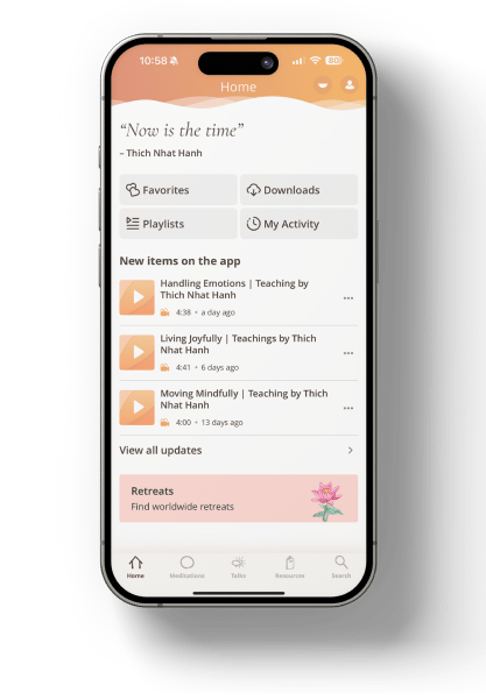Mindful Breathing – A Wakeful Life
In our daily lives, we all breathe, yet we often forget we are breathing. Our body is here, but our mind may be elsewhere. We are often bound by the past, pulled into the future, or lost in the present. As a result, we cannot connect with what is wholesome and nourishing. In such moments, we can return to the practice of mindful breathing to calm our mind. This practice, bringing attention to the in-breath and out-breath, is a method to unify body and mind, helping us be fully present in the here and now. When body and mind are united, we can touch the refreshing wonders of life. While this may seem simple, its effects are profound. This practice is called mindfulness or conscious breathing. It is a teaching directly from the Buddha, a simple and accessible way to find joy and peace amidst the busyness of life.
Practicing mindful breathing is like drinking a refreshing glass of water. Simply recognize and embrace your breath as a mother would gently care for her child returning home. You breathe in and feel the air entering, breathe out and feel the air leaving. We practice:
Breathing in, I know I am breathing in.
Breathing out, I know I am breathing out.
After a few breaths, you may only need to remember "in" and "out." This is not thinking, it is simple awareness. Do not force or control the breath. If your breath is short or not yet smooth, just let it be. We only need to be mindful of it. With the light of mindfulness, the breath naturally becomes more refined, deeper, and gentler.
Breathing in, I notice my breath is deeper.
Breathing out, I notice my breath is slower.
Continue following the breath through its entire length (from the beginning to the end). This helps end the stream of thoughts and gives you a chance to rest. You no longer face worries and fears.
Breathing in, I follow the breath from beginning to end
Breathing out, I follow the breath all the way to its end
In daily life, we often neglect or distract ourselves from our body. Practicing mindful breathing with a gentle smile can release the tension from your face. Now, it is an opportunity to return to the body, to recognize its presence, and to reacquaint yourself with it.
Breathing in, I am aware of my body.
Breathing out, I release all tension in my body.
When you offer relaxation and harmony to your body, helping it release stress, you can then pay attention to any painful sensations within. The energy of mindfulness will embrace those painful feelings. When the body is tense or in pain, your breath is affected. Therefore, the quality of your breath reflects the state of your body and sensations.
Breathing in, I notice the pain in my body.
Breathing out, I smile to the pain in my body
When you bring your attention to the breath, you are bringing your mind back to reunite with your body. In this moment, we know we are alive and experiencing life. The key and the miracle is that you can connect with what is present within and around you. The eyes are a miracle; by simply opening them, we can experience the heaven of colors: warm sunlight, blue sky, yellow leaves, drifting clouds... The ears too are a miracle; we can hear sounds like birds singing, the wind blowing through pine trees... And you can enjoy these moments of stillness and nourishment.
Breathing in, I recognize the blue sky
Breathing out, I smile to the blue sky
Breathing in, I recognize the beautiful autumn leaves
Breathing out, I smile to the beautiful autumn leaves
You can simplify this:
Blue sky – Inhale
Smile – Exhale
Yellow leaves – Inhale
Smile – Exhale
When you breathe mindfully, you are mindful of the breath. When you walk mindfully, you are mindful of each step. Mindfulness can be brought to physical and mental objects, offering recognition and lightness. Life can only be present in the here and now. The most important thing is to be present now, in this moment, to fully enjoy each passing moment.
Inhale, calm mind
Exhale, smile gently
Resting in the present moment
This beautiful moment.
In, out
Deep, slow
Strong, light
Calm, smile
Present, wonderful
The first two words, "In, out," mean: "I know I am breathing in; I know I am breathing out." When breathing in, you focus only on the in-breath. No thinking, just full attention to the in-breath. Similarly, when breathing out, focus entirely on the out-breath. This is the first exercise. Continue silently saying "In, out" while breathing, following the breath from start to finish.
Do not let your mind wander away from the breath: "In, I know... oh, I forgot to turn off the light!" That is not mindfulness, because the mind is jumping from one thing to another. We must follow the breath from beginning to end. A breath lasts only four or five seconds. Anyone can be 100% mindful for the full length of a breath. If you practice mindful breathing for a minute, you stop thinking for a minute. It is wonderful to stop thinking and just live. Most of our thoughts obstruct our living because when we are lost in thought, we are not present; we are not truly living, not touching the miracles of life. "I think, therefore I do not exist." "I think, therefore I am lost in the forest of thoughts." Being lost in thought means not being present.
Imagine your child is beside you, smiling like a beautiful flower. But you are busy thinking about the past, the future, your projects, or feeling anxious or sad—you are lost in thought. At that moment, your child is not really there for you, because you are not there for them. You are somewhere lost in your thoughts. As soon as you stop thinking, you are present in the moment, here and now, able to connect with the miracles of life, including your child.
Just one breath in and one breath out is enough to stop the habit of thinking and return to the present moment—here and now. When you breathe mindfully, your mind immediately reunites with the body. In daily life, the body may be here, but the mind might be drifting somewhere else. Fortunately, we have the breath. The breath is the bridge that connects body and mind. As soon as we breathe a mindful breath, body and mind unite. It is miraculous, so simple, and doesn't take much time—just five or ten seconds—and suddenly, the mind is no longer scattered. We have mindfulness, concentration, and presence. When body and mind unite, we are truly present. When we are truly present, everything else is present—life is present, our loved ones are present.
When driving, we must pay attention to our breath. To drive safely, we must truly be present while driving. When watering the flowers, we also practice mindful breathing to truly be present and enjoy the flowers, feeling joy as we water them.
Once we know how to practice mindful breathing while driving, washing dishes, or walking, we can invite our family members to practice as well. The whole family can sit together, practice mindful breathing, and enjoy each other's presence in warmth and peace. There’s no need to watch TV. Later, we can share this practice with friends at work. We can teach them how to care for themselves when tired, emotional, or sad.
At this point, I invite you to pause reading and take one, two, or three minutes to practice mindful breathing until you are truly focused on your breath. You will discover that the quality of your breath improves quickly. Do not force it. Just let it be natural, and soon your in-breath will become deeper, your out-breath slower, more relaxing, and gentle.





